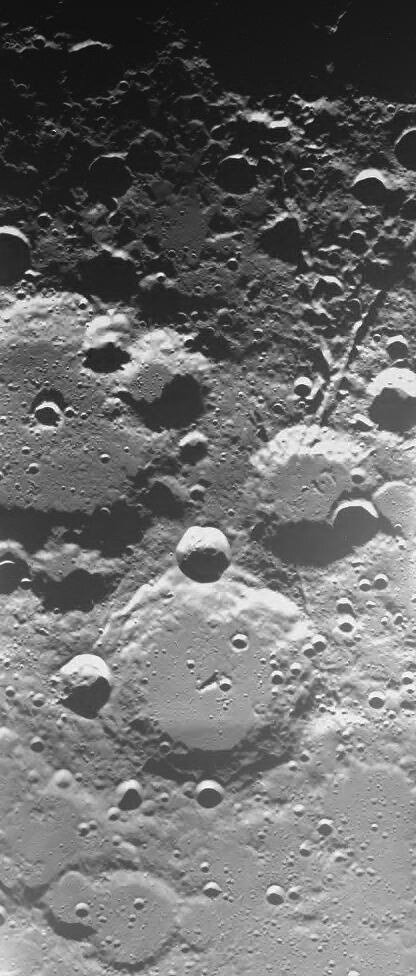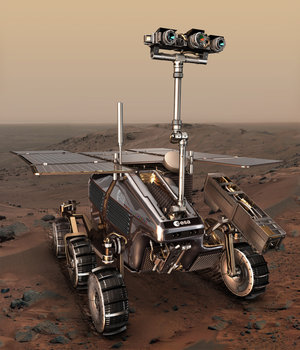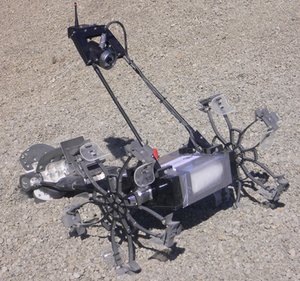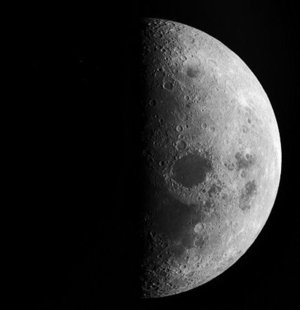Why a Lunar Robotics Challenge?
The ESA Education supported Lunar Robotics programme is no longer running
Many space exploration plans proposed by different parties include the Moon as main objective as well as a stepping stone towards Mars. The Moon offers several advantages as base for planetary exploration.
One of the advantages is the availability of raw materials for building and running a base. One of the materials that would be tremendously advantageous is water.
Is there water on the Moon? In 1994, the USA Clementine spacecraft orbited the Moon and mapped its surface. Clementine also beamed radio waves into craters near the Moon's south pole. The reflections, received by antennas on Earth, seemed to come from icy material. Scientists postulated that water could be trapped, frozen solid, in the permanent shadows of deep, cold craters, safe from vaporizing sunlight.
In 1998, the NASA Lunar Prospector spacecraft, using a neutron spectrometer, detected high concentrations of hydrogen in the same polar craters. Many scientists believed that this was an even stronger indication on the presence of water.
In 2005 ESA’s SMART-1 spacecraft, although not looking for water, increased the knowledge about permanently shadowed craters around both the North and the South Poles.

In summary, the question whether there is water or not on the Moon still waits for a more definitive answer. What is clear is that the Moon possesses hydrogen-rich rocks, and to access this, one needs to go down into the cold, dark craters.
Landing directly into the craters poses risks for the safety of the lander and for the preservation of the ore (which might be wiped out by the hot exhaust of the landing rockets).
Engineers believe that a better option is to land nearby the crater (or on the crater rim, for large craters) and descend into the crater by some robotic means.
Which robotic technologies will be the best? The harshness of the surface features (steep slopes, boulders, terraces), the extremes of the thermal environment (cold temperature), the complications of operation (limited lighting) and flimsy communication (no guaranteed line of sight) make questionable well-proven solutions (e.g. wheeled rovers) and open up the possibility of using new concepts.
Engineers have postulated the use of a wide variety of robotics techniques (e.g. walking/hopping/rolling rovers, cable ways, tethered tumbleweeds, harpoons) which despite their basic different working principles have in common one characteristic: lack of experimental proof of the concept.
The ESA Lunar Robotics Challenge has been conceived as a way of sparking interest in robotic exploration, stimulating the discovery of new innovative ideas and investigating, in a practical way, several of these concepts at the same time.
Challenge Objectives

The activity aims at setting up and running a European competition (or Challenge) for university students having as the major objective a robotic descent into a lunar-like crater, in order to perform soil and rock sampling with the specific goal of detecting water or its components in whatever form may be present.
The competition focuses on the challenges imposed by locomotion in the extremely harsh environment of craters at the lunar poles, where water ice is suspected to exist in the permanently shaded regions, e.g. Shackleton crater.
These areas are not only of crucial importance for future Moon exploration programmes aiming at in situ resource utilisation, but are far more difficult to traverse than typical Martian terrains (especially for younger craters) due to their steepness near the crater rim, debris obstacles and solar power generation/thermal constraints imposed by the permanent shadow in the crater and the points of eternal sunlight on the rim. Numerous techniques and approaches to tackle this challenging terrain are therefore possible, which will inspire students’ conceptual thinking.
Challenge Scenario
The Challenge assumes the following hypothetical mission scenario:
- A lunar lander touches down in proximity of the rim of the target lunar crater. The lunar lander is equipped with:
- Some sort of robotics means that allows collection of soil samples from the crater bottom;
- A lunar ascent vehicle that allows return to Earth of the samples;
- Telecom equipment that allows continuous, high bandwidth, direct communication with Earth;
- Power generation and storage system that allow to power the robotics means (either through a tether or by recharging batteries).
- The robotic vehicle (the element to be designed and built by the participants)
- deploy from the lander;
- move over the crater rim;
- reach the bottom of the crater;
- search for and collect interesting soil samples;
- return the samples to the lunar lander.
- Some sort of automated means for the lander to collect the samples from the robotic vehicle and install them into the lunar ascent vehicle.
- The lunar ascent vehicle blasts off and returns to Earth.
The Challenge focuses only on the requirements in section 2.










